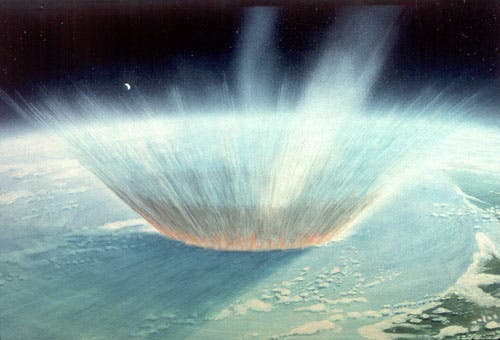Around 65.5 million years ago a 10-km wide asteroid crashed into the Yucatan Peninsula in today’s Mexico, suddenly altering all life on the planet. The giant asteroid carved out immense quantities of debris that, aided by wind, traveled across the atmosphere blocking the sun. As if this wasn’t enough, Berkeley research suggests the planet was going through “dramatic climate variation” in the millions of years preceding the event, such as very cold periods in the tropical environment that the dinosaurs were used to.
The asteroid impact was likely the last straw. All dinosaurs went extinct, along with 60 to 80 percent of all life on Earth.

This tragic event has remained etched permanently in the planet’s geological history, through a band called the K-T Boundary, which separates the Cretaceous and Tertiary periods in geologic history. That and the gaping scar of the 180-kilometer-wide crater rim called Chicxulub.
Oddly enough, the crater was discovered only twenty years ago. Previously, scientists called to the attention of a a thin layer of iridium that could be found in rocks all over the world and dated around the time of the dinosaurs’ demise. This material is extraterrestrial, typically found in asteroids, but also in some volcanic ejections. In 1991, Alan Hildebrand, a geologist at the University of Calgary in Canada, found shocked quartz and a layer of iridium-enriched dust in samples collected in the 1950s by Mexican geologists looking for oil at the Chicxulub and this ultimately led to finding the crater.
In the 25 years since the asteroid’s impact ground zero was pinpointed scientists have learned a lot about how this event altered the planet. There is only so much you can learn from near surface excavations and models, though. Now, a ground breaking project aims to drill 1,500 meters inside the crater. Cores retrieved from the site will help scientists reconstitute more precisely how the impact took place, how the planetary system responded and also how life rebounded in the aftermath.
The project is a collaboration between the European Consortium for Ocean Research Drilling (part of the International Ocean Discovery Program) and the International Continental Scientific Drilling Program.
Just week from now, a special vessel will anchor 30 km offshore from Chicxulub. In these 17m deep waters, the vessel will deploy three pylons which will rise above the water. In this stable configuration, a diamond-tipped drill will pierce right through the peak ring of the crater — a ring of mountainlike structures around the center of the crater. Samples will be taken every three meters, a process which is expected to take two months.
Although offshore drilling can be prohibitively expensive, it sidelines some of the hurdles the project could have faced by drilling on site, like environmental permits and the poor access roads.
Researchers expect to first cut through 500 meters of limestone deposited by the ocean since the impact took place. As they delve deeper, fewer fossilized shell-bearing species should be encountered since life was barely recovering from the impact. Since there was so much CO2 spewed into the atmosphere, the waters around the time of the impact should have been highly acidic. This should be seen evident from whatever fossils they bring back in the cores.
One big question mark this project will help answer is how the peak ring itself formed. The leading model at this time is that granite rebounded temporarily acting like a liquid (i.e. like the water from a lake hit by a stone) to form a high tower. This tower last for a couple of minutes until it collapsed and collided with material slumping in from the rims. “We’ve never gotten a rock back from a peak ring to know if that’s correct,” said Sean Gulick, of The University of Texas at Austin Institute for Geophysics.
The researchers also hope to find details about the process that weakened the granite of the crust to get it to flow like a liquid, Gulick noted. “We don’t understand that process,” he said. Remote sensing suggests the peak ring granite is less dense — a sign that the rock is porous. It’s very likely that hot water oozed through these nooks and crannies, trapping microbes. Microbes could be found still living in these fractures and by sequencing their DNA scientists could find who knows what. We could learn not only how life went extinct, but also how new life thrived. There are winners and losers to any story.






